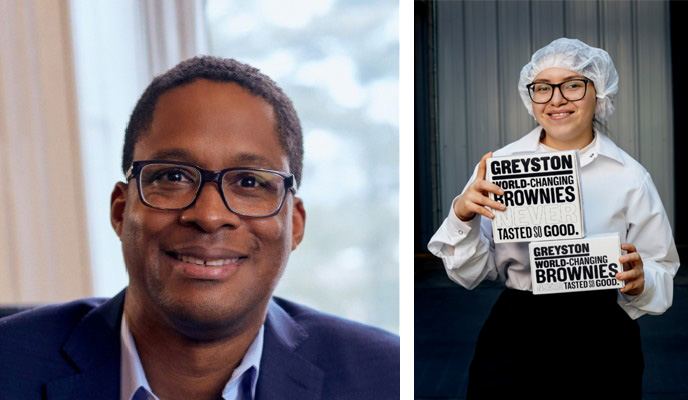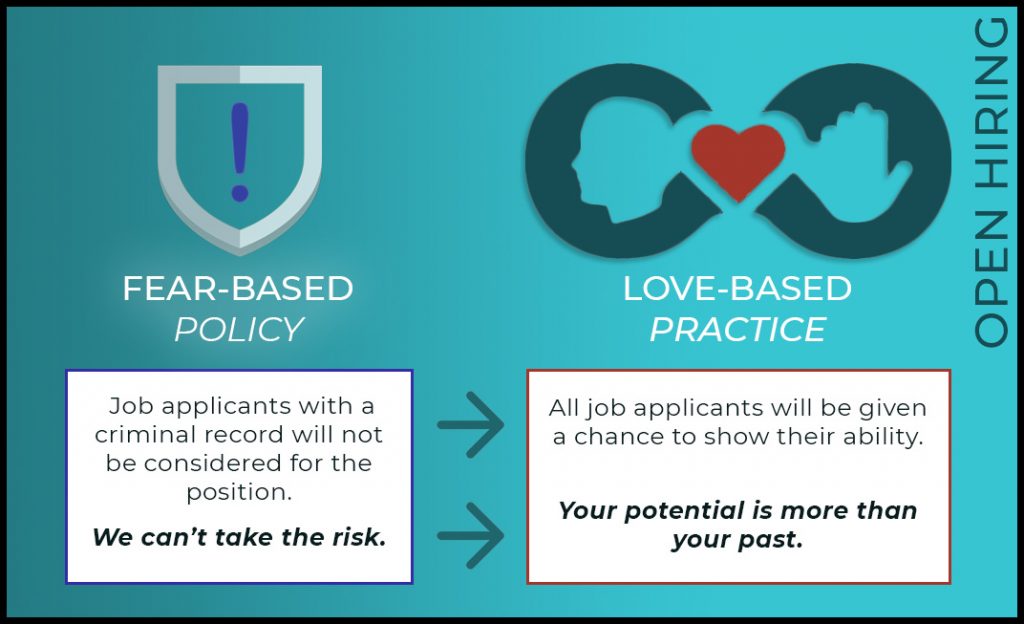Joe Kenner: Open Hiring at Greyston

What would you do if no one would give you a job? Not only that, what if no one would even give you an interview? Feel that desperation coming home to your family every night empty handed. ——–> Then, one day you find a company that only asked for your name and contact info. As soon as the next job opens up it’s yours. No interviews. No background check. Welcome to open hiring.
Joe Kenner, President & CEO of Greyston, stopped by the Contribution Community today to share the story of how Greyston Bakery has been changing lives in Yonkers, NY since 1982. They’ve refined their model of open hiring, focusing particularly around helping the formerly incarcerated to get back to work. According to Joe, there’s a window of time between 30-79 days when someone who’s just been released from prison desperately needs to find work. When they do, recidivism rates plummet.
Now, if you have worked in HR or management a big neon sign might have just lit up in your head, flashing “LIABILITY.” But, hold on. Joe makes it clear that while they remove the barriers to employment, if anything they have strengthened their standards. They use a “points system” to help enforce behavioral norms and expectations. Fail to show up on time – points. Fail quality standards – points. Insubordinate – points. Harassment of any kind – points. Too many points and you’re out. “We’re not shy about letting you go if you can’t adhere [to our standards],” says Joe.
Learn more about Open Hiring at Greyston.
What goes out the door are the barriers, but the standards are alive and well.
Open Hiring is an Urgent, Industry-Wide Need
Looking at labor market, Joe says, “we’ve got to do something different in terms of hiring… 10 million unfilled jobs, another 10 million people are about to lose their benefits, another 9 or so are unemployed and looking for work.” According to the US Chamber of Commerce, the number of unfilled jobs in July was up by 2 million over pre-pandemic records. Not only that, but the Available Worker Ratio is falling dramatically. Almost 4 million people quit their job in April, and 3.6 quit in May. For employers struggling to fill open jobs, it’s time to do some soul searching.
Average cost to hire a new employee: $4,129 ——> Average cost at Greyston: $130
Average time to hire a new employee: 36 days ——> Average time to hire at Greyston: < 7 days
What if the Hiring Practices status quo has major problems? We already know from an 85 year study that interviews are lousy at predicting job performance (they improve predictions by only 4%). Check out Fast Company’s summary of the findings. But, what these studies don’t show us is how much potential value we’re excluding before candidates even get an interview.
Of course, some positions need filters to make sure the candidates have requisite expertise. But, on almost every level, it’s possible to widen our funnel. So, what has to shift to make an open, or at least more open, hiring practice work?
We focus on the future; we don’t focus on the past.
A Certain Set of Skills: Lessons from Open Hiring
To help new hires get up and running, Greyston keeps a full time trainer on staff. Their work includes professional development AND personal development; hard skills AND soft skills (“essential skills” as Joe calls them). They take nothing for granted. Some of the people they hire don’t even have a bank account when they start. They offer training programs to teach basic life management skills that are foundational to holding down a job. And, it’s working. In fact, 25% of their leadership is made up of people who came through the open hiring bakery. Your potential simply can’t be dismissed because you don’t look like the “ideal” candidate. And this leads to our last points. Even if your company doesn’t embrace open hiring right away there’s something we can learn from how it works.
Embrace High-touch, Responsive Training
First, too many companies offer perfunctory and one-size-fits all training for new and developing employees. We make too many assumptions about what knowledge and skills new recruits come in with. Companies that practice open hiring can’t make that assumption. They listen deeply to their new hires to understand their needs and provide them with customized training to help them succeed. Go back and look at how your company approaches employee onboarding and training.
- What assumptions are you making about employees’ knowledge or abilities by what’s left out of your training?
- Are you listening deeply to meet the employee where they are and not where you assume they should be?
Deal Directly and Openly with Bad Behavior
Second, we’ve got to stop letting bad behavior go unchecked. Many companies are so risk averse to dealing with problem employees that they let them stay around for years, draining productivity and toxifying their culture. Sure, we might be tough on strict job performance, but what about cultural problems? What about rudeness, lateness, or harassment? In too many companies reporting a problem to HR feels like shouting into the wind – we know nothing will happen. Greyston uses their points system to make it clear to everyone what’s acceptable and unacceptable behavior. Again, don’t assume people will treat everyone with respect and maturity because it’s a “professional setting.”
- At your company, is maintaining a healthy, respectful culture aspirational or accountable?
- Do your employees trust that if behavior problems are reported to HR that they will be dealt with?
Management Must be Fully Bought In
Open hiring isn’t easy. And, it’s nearly impossible if you have senior leadership consciously or unconsciously undermining it. So, if you’re going to make a move toward more open hiring, socialize it early and often. If you’re serious about it, you might have to change out who is leading your organization. Joe makes it clear that if a leader at Greyston doesn’t share their value of truly equal opportunity employment then they’re out.
- Update your leadership development programs to emphasize managing through future accountability vs. past performance.
- Add to your leadership agenda regular assessments of who is being filtered out by your hiring and screening processes.

Read about a woman that came out of the prison system and is now leading a prison-to-workforce pipeline: Michelle Cirocco on Restoring the Right to Work

You must be logged in to post a comment.